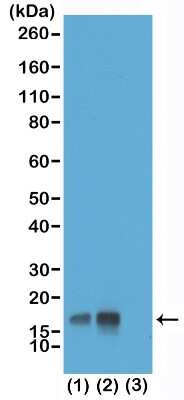Histone H3 [p Thr3] Antibody (RM159)
Novus Biologicals, part of Bio-Techne | Catalog # NBP2-61546
Recombinant Monoclonal Antibody.


Conjugate
Catalog #
Forumulation
Catalog #
Key Product Details
Validated by
Biological Validation
Species Reactivity
Validated:
Human, Vertebrate
Cited:
Human
Applications
Validated:
ELISA, Immunocytochemistry/ Immunofluorescence, Immunohistochemistry, Multiplex Immunoassay, Western Blot
Cited:
Western Blot
Label
Unconjugated
Antibody Source
Recombinant Monoclonal Rabbit IgG Clone # RM159
Concentration
1 mg/ml
Product Specifications
Immunogen
This Histone H3 [p Thr3] antibody (RM159) was raised against a phospho-peptide corresponding to Histone H3 [p Thr3]
Reactivity Notes
Human reactivity reported in scientific literature (PMID: 30348810).
Modification
p Thr3
Specificity
This Histone H3 [p Thr3] antibody (RM159) reacts to Histone H3 phosphorylated at Threonine 3. No cross reactivity with other phosphorylated histones
Clonality
Monoclonal
Host
Rabbit
Isotype
IgG
Theoretical MW
15 kDa.
Disclaimer note: The observed molecular weight of the protein may vary from the listed predicted molecular weight due to post translational modifications, post translation cleavages, relative charges, and other experimental factors.
Disclaimer note: The observed molecular weight of the protein may vary from the listed predicted molecular weight due to post translational modifications, post translation cleavages, relative charges, and other experimental factors.
Scientific Data Images for Histone H3 [p Thr3] Antibody (RM159)
Western Blot: Histone H3 [p Thr3] Antibody (RM159) [NBP2-61546] - Western Blot of acid extracts of HeLa cells non-treated (1) or treated (2) with Nocodazole, and recombinant Histone H3.3 (3). Using NBP2-61546, showed a band of Histone H3 phosphorylated at threonine 3 in HeLa cells. Observed molecular weight is ~17 kDa.
Immunocytochemistry/Immunofluorescence: Histone H3 [p Thr3] Antibody (RM159) [NBP2-61546] - Immunocytochemistry of HeLa cells using NBP2-61546 (red). Actin filaments have been labeled with fluorescein phalloidin (green).
Immunocytochemistry/Immunofluorescence: Histone H3 [p Thr3] Antibody (RM159) [NBP2-61546] - Immunocytochemistry of HeLa cells using NBP2-61546 (red). Actin filaments have been labeled with fluorescein phalloidin (green).
Applications for Histone H3 [p Thr3] Antibody (RM159)
Application
Recommended Usage
ELISA
0.2 ug/mL - 1 ug/mL
Immunocytochemistry/ Immunofluorescence
0.5 ug/ml - 2 ug/ml
Immunohistochemistry
0.5 ug/ml - 2 ug/ml
Multiplex Immunoassay
0.1 ug/ml - 1 ug/ml
Western Blot
0.1 ug/ml-1 ug/ml
Formulation, Preparation, and Storage
Purification
Protein A purified
Formulation
50% Glycerol/PBS, 1% BSA
Preservative
0.09% Sodium Azide
Concentration
1 mg/ml
Shipping
The product is shipped with polar packs. Upon receipt, store it immediately at the temperature recommended below.
Stability & Storage
Store at -20C. Avoid freeze-thaw cycles.
Background: Histone H3
Histones are nuclear proteins responsible for the nucleosome structure of the chromosomal fiber in eukaryotes. Changes in chromatin structure play a large role in the regulation of transcription. The chromatin fibers are compacted through the interaction of a linker histone, H1, with the DNA between the nucleosomes to form higher order chromatin structures.
Common histone modifications include methylation of lysine and arginine, acetylation of lysine, phosphorylation of threonine and serine, and sumoylation, biotinylation, and ubiquitylation of lysine. Posttranslational modifications such as acetylation of core histones regulates gene expression, thus altering protein function and regulation (1). Histone H3 is primarily acetylated at lysines 9, 14, 18, and 23 and have a theoretical molecular weight of 15 kDa. Acetylation at lysine 9 and 14 appears to control histone deposition, chromatin assembly and active transcription. Methylation of arginine residues within histone H3 has also been linked to transcription regulation. Histone H3 has been linked to various types of cancer as a biomarker through the aberrant expression of histone deacetylase (HDAC) enzymes and changes to chromatins (2-4).
References
1. Zhang, Y. X., Akumuo, R. C., Espana, R. A., Yan, C. X., Gao, W. J., & Li, Y. C. (2018). The histone demethylase KDM6B in the medial prefrontal cortex epigenetically regulates cocaine reward memory. Neuropharmacology, 141, 113-125. doi:10.1016/j.neuropharm.2018.08.030
2. Nandakumar, V., Hansen, N., Glenn, H. L., Han, J. H., Helland, S., Hernandez, K, ...Meldrum, D. R. (2016). Vorinostat differentially alters 3D nuclear structure of cancer and non-cancerous esophageal cells. Sci Rep, 6, 30593. doi:10.1038/srep30593
3. Zhou, M., Li, Y., Lin, S., Chen, Y., Qian, Y., Zhao, Z., & Fan, H. (2019). H3K9me3, H3K36me3, and H4K20me3 Expression Correlates with Patient Outcome in Esophageal Squamous Cell Carcinoma as Epigenetic Markers. Dig Dis Sci, 64(8), 2147-2157. doi:10.1007/s10620-019-05529-2
4. Li, Y., Guo, D., Sun, R., Chen, P., Qian, Q., & Fan, H. (2019). Methylation Patterns of Lys9 and Lys27 on Histone H3 Correlate with Patient Outcome in Gastric Cancer. Dig Dis Sci, 64(2), 439-446. doi:10.1007/s10620-018-5341-8
Alternate Names
H3F3A, H3T3p
Gene Symbol
H3C14
Additional Histone H3 Products
Product Documents for Histone H3 [p Thr3] Antibody (RM159)
Product Specific Notices for Histone H3 [p Thr3] Antibody (RM159)
This product is for research use only and is not approved for use in humans or in clinical diagnosis. Primary Antibodies are guaranteed for 1 year from date of receipt.
Loading...
Loading...
Loading...
Loading...


![Immunohistochemistry-Paraffin: Histone H3 [p Thr3] Antibody (RM159) [NBP2-61546] - Histone H3 [p Thr3] Antibody (RM159)](https://resources.bio-techne.com/images/products/nbp2-61546_rabbit-monoclonal-histone-h3-p-thr3-antibody-rm159-131020231935490.png)